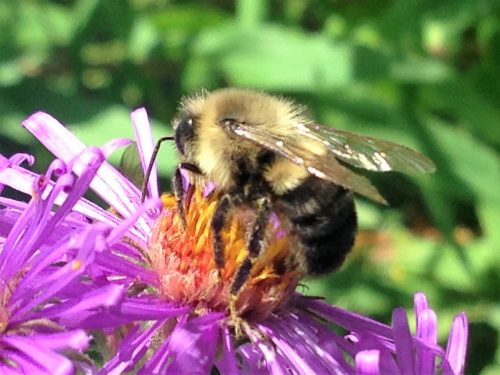
Bombus, photographed by Gretel Kiefer
Family: Apidae
Genus: Bombus
Common Name: Bumble Bees
Length: 10-23 mm (0.4-0.9 in)
Link to DiscoverLife: Bombus
Identification: Bombus individuals are robust and hairy, with yellow, black, white, brown, or orange bands by which different species can be distinguished (with variation). The females carry pollen in hair baskets (cobiculae) on their hind legs.
Foraging Habits: Generalists. Bombus are among the first bees to emerge in the spring and the last to disappear in the fall. Many species of Bombus have long tongues that enable them to access nectar from deep flowers. Furthermore, Bombus can “buzz pollinate” flowers that need to be vibrated to release pollen. They do this by grabbing onto the flower and then vibrating their flight muscles without flapping their wings, making an audible buzz, which reaches a frequency of middle C. Bombus are common in our study area, but they are not visitors to Echinacea.
Nesting Habits: Bombus nest socially in annual colonies. At the end of the summer most bumblebees die, leaving only a few mated queens to hibernate. In the spring these queens form new colonies as solitary bees. The nests consist of irregular clusters of ball-like, wax brood cells in a small cavity. These cells are unique because they may contain multiple offspring and are enlarged as the larvae develop, as additional provisions added as required.
Specimens in Collection: 6 specimens
Species Observed: Bombus fervidus
Supplemental Images: Bombus fervidus
(Mader et al. Attracting Native Pollinators: Protecting North America’s Bees and Butterflies. 2011. The Xerces Society.)
Bombus is very uncommon at our study site in Minnesota, perhaps because it is more interested in the nectar of a flower than the pollen. It is possible that is why this Bombus searches through the flower and leaves much of the bountiful pollen intact and uncollected, then flies away. Several species of Bombus are common in the area and may infrequently visit Echinacea, such as this potential Bombus bimaculatus, however we only have Bombus fervidus in our collection. More videos of bees visiting Echinacea are available on the Echinacea Project Youtube.
